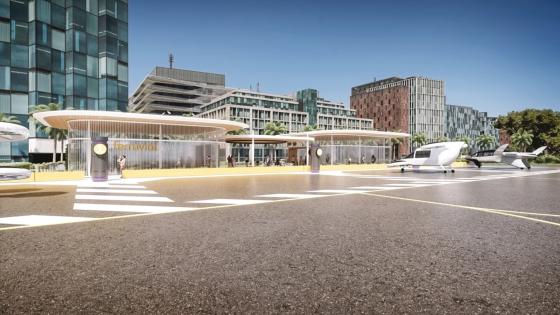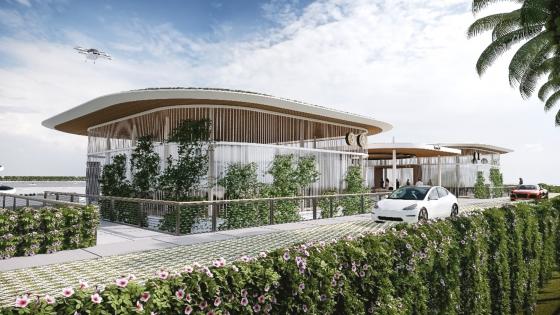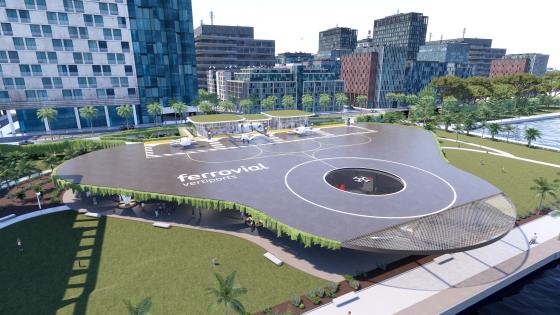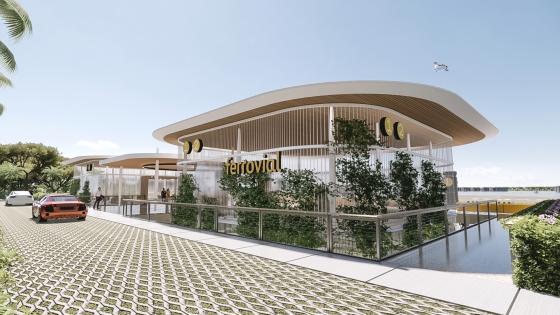Ferrovial Vertiports aims to turn aviation on its head. CEO Kevin Cox tells Tara Craig how and why
Ferrovial is well established in the airports sector: what will you bring to vertiports?
About five years ago, Ferrovial began looking at things we do well, for instance investing in, constructing and operating some of the largest airports in the world – from Heathrow to JFK’s New Terminal One and also Dalaman in Türkiye. There are a lot of construction capabilities in the group, and a lot of operational capabilities.
Then there’s our innovation group. We have forward-looking thinkers who realise that electric vertical take-off and landing [eVTOL] aircraft are not that far from commercial viability. So we can take all the things that we do well and bring them to a brand-new sector, one we believe will be transformative.
Why venture into a new sector now, at a time of social and economic instability?
When you build transportation infrastructure, you don't build it for today or a week or even a year from today. You build it knowing that it’s going to deliver long-term benefits.
World Bank data today shows more than 56% of the world’s population is living in congested cities, but by 2050 the population is scheduled to double and over 70% of the world’s population will be in cities. We are looking for clean, quiet, efficient and green transportation. We fundamentally believe that over the next two to three decades how people move will be transformed. And because of that, we are investing for the long haul.

Ferrovial Vertiports CEO Kevin Cox has more than 30 years’ experience in the aviation sector
You cherry picked your senior team from across the airports and advanced air mobility (AAM) sectors: tell me what was behind your hiring decisions
Ferrovial Vertiports is a start-up within a very large company. We believe we have a fundamental advantage right up front that most vertiport operators don’t have. We also recognised that we needed to stand up inside this group, as a new company, and to bring in some folks from across the industry.
This is the most experienced, capable and battle tested team out there
We have made a conscious choice to hire extremely qualified people with decades of experience in a variety of aviation matters. Each member of our senior leadership team has more than 25 years’ experience in aviation transportation. We have people who have led or held senior positions at airlines and airports, even The House Transportation Infrastructure Committee and the Department of Transportation.
This is the most experienced, capable and battle-tested team out there. We feel it’s a unique time in aviation history where we can turn aviation on its head by bringing something green and quiet – airports that can be built on an acre to three acres right where the people are, or right where the people want to go. Our team couldn’t be more excited. Nor could the people that we’re working with in the field, and that includes some of our competitors. It’s a very collegial group of folks, all with the same goal of bringing this novel form of transportation to the populace.

Ferrovial Vertiports sees AAM as a means of helping move passengers between their first and last mile destinations as quickly as possible
Tell me about Ferrovial Vertiports’ business strategy
We are building agnostic vertiports designed to serve three primary eVTOL business models: intracity, intra-airline and intercity passenger service, but we’re also agnostic in that we will operate some vertiports, while others will be run by airlines and even helicopter operators. Our goal is to find markets that can accommodate any and all of these eVTOL business models. What’s important is we don’t build the vertiports on speculation – we don’t make that kind of investment without having committed eVTOL partners in place and verified market demand.
We also need to future-proof our vertiports. We know, for example, that battery technology will continue to change. Hydrogen power could come to the market. These aircraft will get longer legs in terms of their ability and range because batteries will improve and increase in power. Our design must be suitable for bigger aircraft, different types of propulsion and different types of missions that will not necessarily occur on day one. It’s got to be adaptable and ready for what our children and our children’s children will be flying.
We also believe there’s a first mover advantage. We think finding those locations in the thickest markets provides an advantage because it offers ‘built-in’ customers. We don’t believe in going to the easier places to construct a vertiport and hope the customer base builds around it.

Building for future generations involves providing clean, quiet, efficient and green transportation, Kevin Cox believes
We have an in-house model for gauging where best to build vertiports. It enables us to use telephone and app data, and to see through aggregators how many people are travelling between any two points on the map, and even the purpose of their trip. If they are commuting, we can tell how long the journey takes and the mode of transport. We can look at ticket prices, too.
We then build a predictive model of how many people we believe we can pull out of surface transportation and into an eVTOL. That then enables us to build heat maps, which indicate where we think the most likely commercial opportunities are. We look at them from 30,000ft, then we go down to street level, because what may look great on the heat map may not look great on a street level in terms of air space, or ingress and egress. It’s no good flying somebody somewhere in 30 to 45 minutes of flight time in one of these aircraft if we can’t get them to and from their first- and last-mile destinations as quickly as possible.
Will your vertiports be by airports or in business areas?
It’s going to be a mixture. We believe there will be some that will be at or near airports – our very first one is on the airport outside the secure area at West Palm Beach – but we’re in negotiations with city centre sites in a variety of locations in and around Florida as well.
There is interest in connecting cities like Fort Lauderdale to Miami, or moving between downtown locations in highly congested cities like New York. And then there will be city centre to airport flights.
We firmly believe that this transportation will start in highly congested areas and most likely until it scales it will primarily attract people who have the ability to pay for that convenience. Over time scaling will drive down the cost and will generate more competition. Once our industry begins to scale, inevitably cost efficiencies will come and we’ll drive the ticket price down. There’s no reason why this mode of transportation can’t be for the masses, similar to how mobile phone service scaled and became more affordable.
Over time scaling will drive down the cost and will generate more competition
We firmly believe that this transportation will start in highly congested areas and most likely until it scales it will primarily attract people who have the ability to pay for that convenience. Over time scaling will drive down the cost and will generate more competition. Once our industry begins to scale, inevitably cost efficiencies will come and we’ll drive the ticket price down. There’s no reason why this mode of transportation can’t be for the masses, similar to how mobile phone service scaled and became more affordable.
What markets will you focus on first, and why?
The best way to market is to focus on those countries with the commercial viability to introduce this aircraft, and a regulatory scheme in place to support it, validated customer usage projections and local communities that want to accept it.
Early on, therefore, we’re going to focus on the United States and Europe. In the US we are focusing initially on Florida and the Northeast Corridor, with a focus on Texas and California in the future. That doesn’t mean that there may not be other viable business markets out there involving South America or Asia, but our focus is going to be on markets in the US and Europe with the highest likelihood of commercial success.
There are many opportunities, and there are many, many operators. OEMs are looking for different entry points into the market and many of them align well with our approach.

‘Intracity’ is one of three eVTOL business models that Ferrovial Vertiports plans to serve
Tell me about your plans for Northeast US
We will start in New York and New Jersey. We have ambitions to build a robust network of vertiports over five to seven years. Again, they’re focused on the thickest markets. Some of them will be feeding airports, which we hope will be interested, while also supporting inter-city or intra-city eVTOL passenger models.
Every market that we’ve analysed is slightly different. The Northeast Corridor – between New York and New Jersey – offers some of the greatest commercial opportunities. Quite honestly, we probably couldn’t build enough vertiports if we wanted to meet what we believe is the demand there. It’s not easy to get from point A to point B.
Are you looking at international routes?
Absolutely. We’re not looking at them now, but we do know that some folks are looking at, as an example, connecting New York with Canada, and we see the same opportunity in Europe.
Challenges exist when you start traversing international borders, because these aircraft are not designed to sit around.
The unique thing about all of this [the vertiports industry] is that there are so many people from so many regions looking into it, and billions of dollars invested in the aircraft. Anybody who has touched the aviation sector over the last 30 to 50 years is focusing on AAM and knows that it is going to happen. It’s not a question of success or how it will change how we move, but how quickly and when it will start. I feel very fortunate to be part of it at this point in my career.

Initially, AAM will be for travellers who are willing to pay more, but it will ultimately be affordable for the masses
How will airports benefit from vertiports learnings?
Each airport is different. There are those that have ‘leaned into’ the vertiports industry, those that have questioned what it means and those that have dismissed it.
Those that are leaning in realise that this is a unique time in the aviation industry and want to figure out how they can best combine it with their form of transportation. In some airports that may involve eVTOLs flying right into the secure area. In others the vertiport may be adjacent to the terminal, or it may be off the airport completely.
All airports need to look at AAM as a complementary form of transportation. Those airports that embrace the opportunity and the technology will be the first beneficiaries of what it can do for their passengers and airlines.
What I always try to emphasise is that this – AAM and vertiports – is going to happen. Explaining the scale of the money, intelligence and resources focused on bringing this technology to market, and that some aircraft will likely be certified and operational by 2025, is an eye-opener for the man or woman in the street. I believe that once commercial operations start, there will be a real desire to adopt the technology as quickly as possible. Instead of us knocking on doors, people will be ringing us up for opportunities to build vertiports. That’s when the real acceleration will happen – and it’s not that far down the road.
